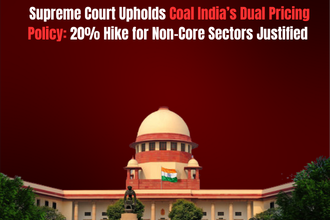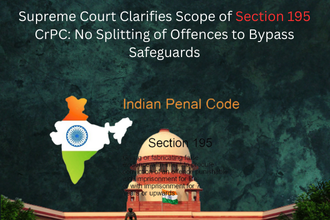In a landmark judgment, the Supreme Court of India upheld the validity of Coal India Limited’s (CIL) 2006 interim coal pricing policy, which introduced a 20% price hike for non-core sector industries. The ruling affirms the government’s power to make reasonable classifications in pricing policies and validates CIL’s dual pricing mechanism, distinguishing between core sectors such as power and steel, and non-core industries producing non-essential goods.
This judgment, delivered on 12 September 2025 by a bench of Justice JB Pardiwala and Justice R Mahadevan, has far-reaching implications for coal pricing, industrial policy, and constitutional interpretation under Article 14 of the Constitution of India.
Background of the Case
The dispute traces back to 2006, when Coal India Limited (CIL) introduced an interim policy imposing a 20% price hike on coal supplied to non-core sector consumers. Core industries such as power, cement, and steel were exempted from this increase, as coal was essential to their production of public utility goods.
Non-core industries—manufacturers of goods like paints, lime, and refractories—challenged this decision as being arbitrary and discriminatory, arguing that CIL had no statutory authority to impose such a unilateral price hike.
The Calcutta High Court sided with these industries, holding that the price hike was discriminatory and directing CIL to provide refunds. Aggrieved, Coal India Limited appealed to the Supreme Court, setting the stage for a significant constitutional and economic debate.
Supreme Court’s Key Observations
The Supreme Court overturned the High Court’s ruling and upheld CIL’s dual pricing policy. The Court’s reasoning rested on several key principles:
1. Reasonable Classification Under Article 14
The Court observed that the classification of core and non-core sectors was not arbitrary but based on reasonable differentia.
- Core sectors, consuming nearly 90% of coal, supply essential goods and services like electricity and steel. A hike in coal prices for these sectors would trigger a cascading effect on the economy, raising the cost of living for millions of citizens.
- Non-core sectors, however, used coal minimally, and products manufactured (e.g., paints, lime, refractories) were not essential for the average consumer. Thus, a price hike in these industries would have negligible public impact.
The Court held that this differentiation fulfilled the test of reasonable classification and did not violate Article 14’s guarantee of equality.
2. Dual Pricing and Public Interest
The Court emphasized that dual pricing policies are permissible so long as they are rational and linked to legitimate objectives. Protecting essential sectors from cost burdens while allowing price hikes for non-essential industries was seen as a balanced and justified approach.
The judgment cited Pallavi Refractories v. Singareni Collieries Co. Ltd. (2005) 2 SCC 227, where dual pricing was previously upheld. In that case, the Court had reasoned that ensuring stable coal prices for essential industries serves the broader public interest.
3. No Vested Right Under the Linkage System
The Court clarified that the coal linkage system—through which industries were “linked” to specific coal mines for supply—was an administrative decision, not a statutory entitlement.
- Linkage only allowed industries to procure coal subject to availability and regulatory directives.
- It conferred no vested right to fixed prices or quantities.
- The system itself was rolled back with the Coal Distribution Policy, 2007, demonstrating its temporary and discretionary nature.
Thus, the non-core industries’ reliance on linkage for equal treatment was held to be untenable.
4. Sustainable Operations and Economic Balance
The Court highlighted that the 20% price hike for non-core sectors mitigated rising operational costs of coal mining by only 1.2% of total expenses, showing that the measure was modest and necessary for CIL’s financial sustainability.
The judgment underscored that public sector undertakings like CIL must operate viably while balancing their public obligations. Dual pricing was a means to ensure sustainable coal production and investment without burdening essential consumers.
Constitutional and Legal Significance
The Supreme Court’s decision is significant for its interpretation of Article 14 and the principle of reasonable classification:
- It reaffirms that equality before the law does not mean treating unlike things alike. Core and non-core industries, given their vastly different coal consumption and public impact, can justifiably be treated differently.
- The ruling strengthens the principle that economic and industrial policies fall within the executive’s discretion, provided they are rational and non-arbitrary.
- By upholding the dual pricing model, the Court emphasized the importance of balancing industrial growth with public welfare.
Impact on Industries and Policy
The ruling has immediate and long-term implications:
For Coal India Limited (CIL)
- The judgment validates CIL’s pricing autonomy, ensuring it can adopt flexible pricing mechanisms without fear of judicial overreach.
- It secures CIL’s ability to balance financial viability with its mandate of serving national interest.
For Core Sector Industries
- Essential sectors like power, steel, and cement remain protected from arbitrary price hikes, ensuring stable input costs and preventing inflationary pressures.
For Non-Core Industries
- While these industries must bear the additional 20% hike, the Court reasoned that the impact is minimal, as their coal consumption is limited and their goods are non-essential.
For Government Policy
- The judgment reinforces the government’s freedom to adopt differential pricing policies in resource allocation, provided they meet the test of reasonable classification.
- It could serve as precedent in disputes involving electricity tariffs, natural gas pricing, and other essential commodities.
Bench and Appearances
- Bench: Justice JB Pardiwala and Justice R Mahadevan
- Case Title: Coal India Ltd. and Ors. v. M/s Rahul Industries and Ors.
- Citation: 2025 LiveLaw (SC) 907
For Petitioners (CIL):
- Mr. Kedar Nath Tripathy, AOR
- Mr. Ravindra Shrivastava, Sr. Adv. (Through VC)
- Mr. Manish Kumar Saran, AOR and team
- Mr. Chinmoy Pradip Sharma, Sr. Adv., with others
For Respondents (Non-Core Industries):
- Mr. Ranjit Kumar Singh, Sr. Adv.
- Mr. Devashish Bharuka, Sr. Adv.
- Ms. Aishwarya Bhati, A.S.G., and others
Conclusion
The Supreme Court’s ruling on Coal India’s dual pricing policy is a critical development in India’s industrial and constitutional jurisprudence. By upholding the 20% price hike for non-core industries, the Court balanced economic rationality, public interest, and constitutional equality.
The judgment reaffirms that:
- Core sectors must be shielded from cost burdens due to their essential role in public welfare.
- Non-core sectors can justifiably bear higher costs, given their limited consumption and minimal public impact.
- Dual pricing policies, when based on sound reasoning, are permissible under Article 14.
As India continues to navigate the challenges of resource allocation, industrial growth, and economic equity, this decision provides clarity and sets a precedent for balancing commercial viability with social responsibility.
Also Read



